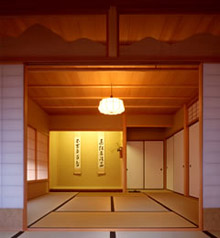Kids Web Japan
Web Japan > Kids Web Japan > Meet the Kids > Chado > Pleasure
Meet the Kids
Chado or Sado
(Tea Ceremony)
Pleasure, Hospitality, and Ichigo Ichie

A tearoom. Sitting in this space brings peace of mind. ©Mushakouji Senke
People who don't know much about chado tend to think of it simply as a procedure in which the host ritually prepares tea and the guest ritually drinks it, each with a specific set of manners. But chado is actually a profound total art that requires a wide range of knowledge and a fine sensitivity; the purpose and philosophy of living, religion, and the tea utensils and art objects displayed in a tearoom are all a part of the art.
Chado is deeply connected to Zen. Zen is a sect of Buddhism, and its teachings have to do with how a person should live the present moment. The Zen spirit is incorporated in many aspects of chado. In fact, it might even be said that Zen thinking lies at the heart of chado. By concentrating on making tea inside a quiet tearoom, people can reach a calm state of mind and reflect on themselves.
Every single thing that is used in a tea ceremony has a meaning. When preparing to welcome a guest into a tearoom, the host must think carefully about the choice of each item, including the tools for making tea, the scroll to hang on the tokonoma (alcove), and the flowers to decorate the room. So the host needs to have a broad knowledge of utensils and fine art, as well as a refined sense of aesthetics. That is why chado is known as a total art that involves every aspect of Japanese life and culture.
There is an important concept in chado known as ichigo ichie. The literal meaning of the term is "one encounter in a lifetime." The philosophy behind it is that one should always do one's best when making tea for another, treasuring each encounter as a once-in-a-lifetime event. Chado does not have a single, clear-cut goal that one should try to attain, as the details of each occasion all depend on the particular people and things that are involved.